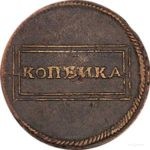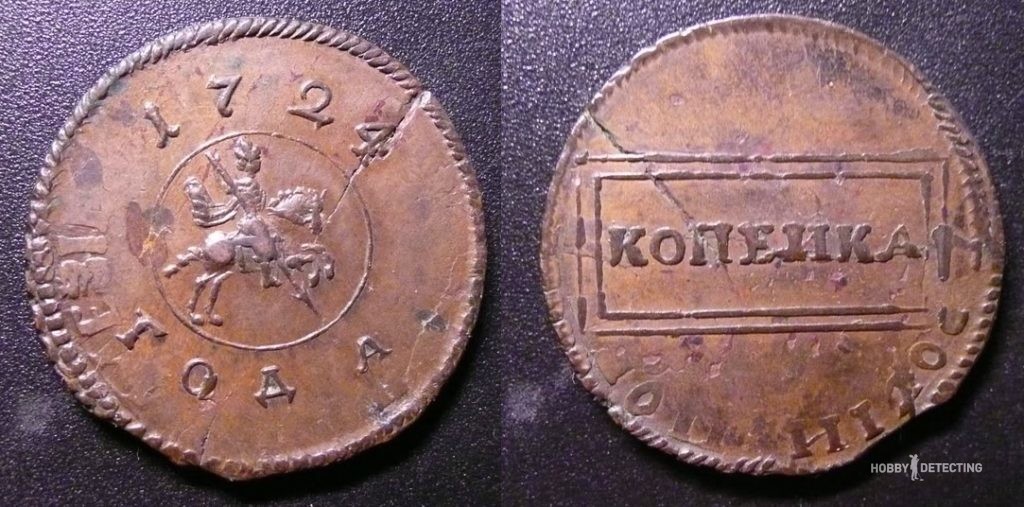Rarik: “frame” penny from 1724 (Identification of finds)
Hello friends!
I decided to conduct a series of posts on a very interesting topic — rare coins or, as people say, «rariki». Yes, these are exactly the coins that every real digger/treasure hunter/searcher dreams of digging up, because what they say is true: «a bad soldier is one who does not dream of becoming a general». Agree?
And in this issue we will talk about a rare coin — penny 1724, also called «frame» a penny. Why frame? When you look at the photo of a penny, the question disappears by itself:
 The coin is a very valuable (one might say — priceless) rarity and the bad collector is the one who does not want to have such a specimen in his collection. However, let’s move on to the topic.
The coin is a very valuable (one might say — priceless) rarity and the bad collector is the one who does not want to have such a specimen in his collection. However, let’s move on to the topic.
History of creation
The history of coinage begins with the reign of Alexei Mikhailovich, «The Quietest» tsar, since officials of the Russian Kingdom have long tried to find a replacement for coins «scales», made of silver, and which were coins that were quite difficult to handle — too small for large trades and too large in denomination for small transactions. And the replacement was planned in the form of copper coins. Let me remind you that in the 16th and 17th centuries, silver in Russia was purchased from abroad, and all coins were made only from silver, which even led to the creation of «efimok» — thalers with a small mintage of the coat of arms of the Russian Kingdom, and copper could be used for monetary transactions, however, due to internal reasons and due to the fact that the Mints in Russia at that time did not have the technology and skills for mass minting of coins from copper, copper coins in Russia did not took root. It was only during the reign of Peter the Great that a monetary reform was carried out and new copper coins began to come into circulation.
However, during the wars, and Russia was then at war with Sweden and military expenses required more money, Peter the Great gradually reduced the copper content in coins, and this, in turn, increased the turnover of counterfeit coins. It is believed that, for example, as many counterfeit coins were issued as real ones and, despite the death penalty, counterfeiters continued to issue counterfeit copper coins. Now that the war with Sweden was over, it was necessary to renovate the tax and monetary system of the state, and Peter began to mint coins with a denomination of five kopecks, and then, exactly a year later, according to the Decree of January 31, 1724, a new one was introduced into circulation. coin — kopeck 1724, our «frame» rarity.
What’s interesting is that basically new kopecks were made by re-minting old kopecks that were issued in the period 1704-1718. There is an assumption that the circulation of one kopeck in 1724 was only 200 thousand units. (According to V. Rzaev — numismatist, author of several interesting books on numismatics.) The coin was issued for only one year — throughout 1724.


Appearance of the coin
As seen in the photo — on the front side of the coin there is a «Horseman with the ground under his feet», and the date and inscription «YEAR» are minted in large numbers, and on the reverse side there is the inscription «KOPEYKA& #187; enclosed in a rectangular frame. The patterned edge is visible, and this made it much more difficult to create a counterfeit coin. The quality of the minting of these kopecks was very high and on many kopecks there are not even traces of the coin that was minted into our rarity.
 The mesh edge is visual.
The mesh edge is visual.
Coin weight 6.69 g.
The coin remained in circulation until 1730, and then began to be gradually withdrawn. But how many of these were lost in the fields and buried in the ground? No answer.
There are also disputes at which mint it was minted, most likely it was minted at the Kadashevsky Mint.

«Framework» kopeck 1724 g, price
Now let’s talk about the best part, the price. When digging up a good specimen and, if you have the patience not to subject it to cleaning and other «experiments», but to hand it over to a specialist in his field for cleaning or conservation (and not Uncle Petya from the neighboring numismatic boutique on the market), at auction such pennies can go for $1000+.
So we have to dig.
I liked it? I’m slowly collecting an encyclopedia, everything by definition of finds is collected here, there’s a lot of useful stuff — coins, shmurdyak and various other, quite valuable finds!
